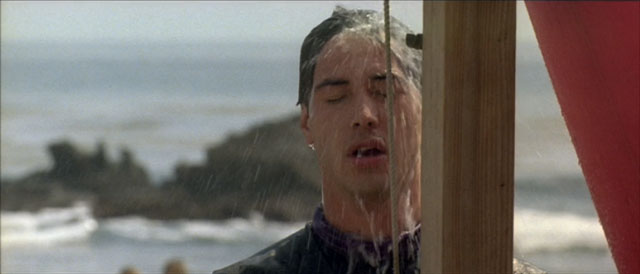Point "Heart" Break, or: Why Bodhi and Johnny Utah Just Want to Bang Each Other
By Anthony Manzi, February 12, 2014
![]() The action film is defined by masculinity. It’s a genre where hard muscles and big guns are the engine, and testosterone is the fuel. The genre has succeeded for decades with male audiences by staying true to a simple formula: men behaving manly in the face of lesser men in order to validate their own superior manliness. The heroes of the action film are the definition of the heterosexual man. They’re fearless, taciturn, stoic, virile, and above all, deeply faithful to the masculine construct. The entire structure of the genre was built around this androcentric ideology. It’s a genre created by men, for men, in celebration of men. Classic action films don’t just reaffirm this ideology, they force it down the viewer’s gaze, indoctrinating the values that heterosexual men are supposed to hold sacred. And yet, after seeing enough action films, an unintentional pattern begins to emerge, a pattern that is buried deep beneath the masculinity. It’s a phenomenon that’s inherent to the genre, yet antithetical to the genre’s ideals. No matter how much the action film adheres to its established structure, the pattern is always present, tapping faintly in the distance like a persistent drip, waiting to be discovered. In 1991, a single pioneering action film was made that not only exposed the pattern, but pulled back the genre’s curtain completely, revealing just how gay the action film really is.
The action film is defined by masculinity. It’s a genre where hard muscles and big guns are the engine, and testosterone is the fuel. The genre has succeeded for decades with male audiences by staying true to a simple formula: men behaving manly in the face of lesser men in order to validate their own superior manliness. The heroes of the action film are the definition of the heterosexual man. They’re fearless, taciturn, stoic, virile, and above all, deeply faithful to the masculine construct. The entire structure of the genre was built around this androcentric ideology. It’s a genre created by men, for men, in celebration of men. Classic action films don’t just reaffirm this ideology, they force it down the viewer’s gaze, indoctrinating the values that heterosexual men are supposed to hold sacred. And yet, after seeing enough action films, an unintentional pattern begins to emerge, a pattern that is buried deep beneath the masculinity. It’s a phenomenon that’s inherent to the genre, yet antithetical to the genre’s ideals. No matter how much the action film adheres to its established structure, the pattern is always present, tapping faintly in the distance like a persistent drip, waiting to be discovered. In 1991, a single pioneering action film was made that not only exposed the pattern, but pulled back the genre’s curtain completely, revealing just how gay the action film really is.


